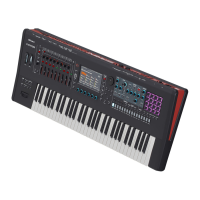17
Sampler
Sampling
This unit lets you create a sample by sampling the following sounds.
5 Keyboard performance
5 Input from the MIC/LINE INPUT jacks 1, 2 (audio device, microphone)
5 Audio input from the USB COMPUTER port
1. As necessary, connect the device (audio device or mic) that
you want to sample to the MIC/LINE INPUT jacks 1 and 2.
MEMO
If you want to sample an audio device in stereo, connect the left channel to MIC/
LINE INPUT jack 1 and the right channel to MIC/LINE INPUT jack 2.
2. Press the [SAMPLING] button to make it blink.
The SAMPLING STANDBY screen appears.
3. Note that the <SAMPLE PAD> button shows the bank and
number of the sample pad to which the sound will be
sampled.
4. If you want to change the bank and number of the sample
pad, touch the <SAMPLE PAD> button.
In the SAMPLING DESTINATION (PAD) screen, specify the sample bank and
number that you want to change.
MEMO
If the pad you’re sampling already contains a sample, the message “Overwrite
OK?” appears. Press the [ENTER] button to overwrite, or press the [EXIT] button to
cancel.
5. Touch <Sampling Mode> to select the sampling mode.
Parameter Explanation
KBD+INPUT
The keyboard performance together with the audio input from
the MIC/LINE INPUT jacks 1 and 2 and the audio input from the
USB COMPUTER port will be sampled.
KBD The keyboard performance is sampled.
INPUT
The audio input from the MIC/LINE INPUT jacks 1 and 2 and the
audio input from the USB COMPUTER port will be sampled.
6. Adjust the sampling volume.
Adjust the volume as high as possible without letting the level meter reach full
scale.
Device to sample Explanation
Audio device
Adjust the rear panel LEVEL
knobs 1 and 2, and the audio
device.
Microphone
Adjust the rear panel LEVEL
knobs 1 and 2.
USB COMPUTER
Adjust the USB Audio Input Level
(p. 22).
7. Make settings for sampling.
Touch an on-screen parameter to turn it on/o, or select a parameter and use the
[VALUE] dial to edit its value.
Parameter Value Explanation
Format
MONO
Samples the sound as a single waveform.
Choose this if you’re using one mic and
sampling in mono.
If you’re inputting in stereo, the L and R sounds
are mixed and sampled.
STEREO
Samples the sound of L and R as two
waveforms.
Choose this if you're sampling in stereo from a
source such as an audio device.
AUTO TRIGGER
LEVEL
0–15
If Auto Trig is “ON,” sampling starts when a
signal that exceeds this setting is input.
AUTO TRIGGER OFF, ON
If this is “ON,” sampling starts when a signal
that exceeds the AUTO TRIGGER LEVEL setting
is input.
If this is “OFF,” sampling starts immediately
when you touch <START>.
8. Produce sound on the device that’s connected to this unit,
and touch <START> at the moment that you want to start
sampling.
During sampling, the screen indicates “NOW SAMPLING!”
If AUTO TRIGGER is set “OFF” in step 7
Sampling starts when you touch <START>.
Produce sound on the device that’s connected to this unit.
If AUTO TRIGGER is set “ON” in step 7
Produce sound on the device that’s connected to this unit; sampling starts when
the input signal exceeds the setting specied by AUTO TRIGGER LEVEL.
9.
Sampling stops, and the sample is saved to the sample destination pad.
MEMO
5 The sampled data is saved in this unit’s sample memory.
5 Audio data from your computer can be loaded as samples. For details,
refer to “Reference Manual” (PDF).
Deleting a Sample (Delete)
Here’s how to delete a sample.
1. Hold down the [SHIFT] button and press the [PAD MODE]
button.
The SAMPLE PAD screen appears.
2. Press a pad to select the sample that you want to delete.
3. Touch <SAMPLE UTILITY>.
4. Touch <DELETE>.
A conrmation message appears.
To cancel, touch <CANCEL>.
5. Touch <OK>.
The sample is deleted.
Setting the Input Volume (Input Setting)
Here’s how to specify the input volume of the device connected to the MIC/LINE INPUT jacks
1 and 2.
1. In the SAMPLING STANDBY screen (p. 17), touch <INPUT
SETTING>.
2. Move the cursor to the desired parameter, and edit the value.
MEMO
For the input volume of the device connected to the USB COMPUTER port, see
“Adjusting the USB Audio Input” (p. 22).
When you want to stop sampling, touch <STOP>.

